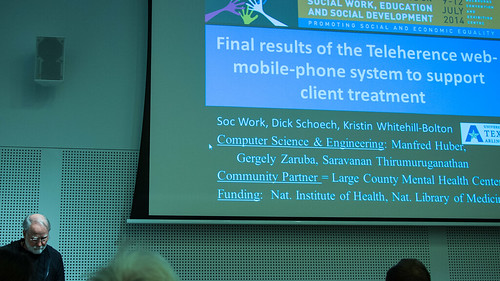Paper presented at #husITa14 in Melbourne, Australia, July, 2014.
Presenter
Dick Schoech (University of Texas Arlington, USA).
Abstract
Care or case management provides outreach and engagement, problem assessment and understanding, service planning of goals and objectives, advocacy and care coordination, referrals to resource, and monitoring plan progress and problem resolution. One major problem is clients’ adherence to service plans, with adherence failures ranging from about 24% to 90%. Recent technology has raised interest in using mobile smartphones to improve outcomes for clients receiving care management.
The goal of the Teleherence project was to improve client mental health outcomes including empowerment, self-efficacy, and clinician-client relationships by increasing their adherence to treatment and services using prediction technology and web-enabled telecommunications between clinicians, clients, and clients’ family and friends.
The Teleherence system allows clinicians to automatically provide voice or text communication with clients. The system could deliver a series of voice or text statements as well as questions that could accept responses from clients, and based on these responses, branch to additional statements or questions or perform other tasks such as playing an audio file.
Four applications of Teleherence found that while potential benefits can be had, many agencies have antiquated computing systems, are constantly threatened with budget cuts and reorganization, have non-standard interventions, and have high staff turnover making a sophisticated automated system difficulty to integrate into existing services. Adapting internet and mobile technology into services takes resources that agencies often prefer to devote to additional services, especially if no research establishes the effectiveness and cost savings of web-phone technologies. Finally, the security and privacy of client data is a constant struggle for agencies and researchers. All these concerns can derail service automation efforts.
This presentation suggests the road ahead in human services web-phone automation offers much potential, but is usually difficult, time consuming, and can substantially change how services are delivered.
Powerpoint
[slideshare id=36935109&doc=sat2171350richardschoechv2-140713204649-phpapp01]
Back to programme

